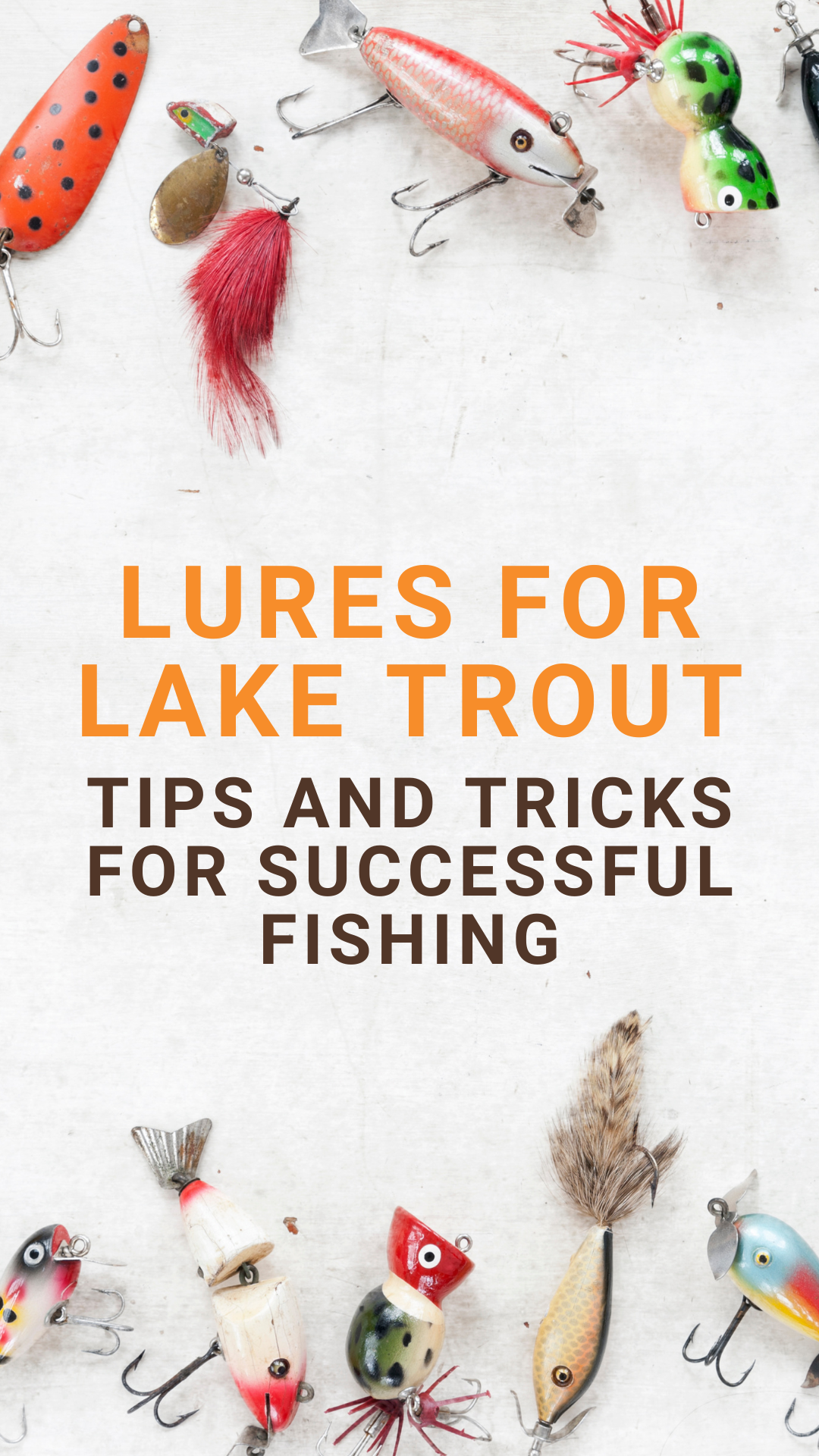Are you looking for the best lures to catch lake trout? Look no further! As avid fishermen, we know how important it is to have the right gear to reel in a big catch. Lake trout can be tricky to catch, but with the right lures and techniques, you can increase your chances of success.

When it comes to lures for lake trout, there are a few key things to keep in mind. First, lake trout are known for their deep-water habits, so you'll want to choose lures that can reach those depths. Second, lake trout are often attracted to flashy or brightly colored lures, so you'll want to choose something that stands out. Finally, lake trout can be picky eaters, so you'll want to have a variety of lures on hand to try out until you find what works best.
Read More: The Art of Mounting a Rainbow Trout
In this article, we'll take a closer look at some of the best lures for lake trout and share some tips and techniques for using them effectively. Whether you're a seasoned angler or just starting out, we hope you'll find this guide helpful in your quest to catch the biggest lake trout around.
Understanding Lake Trout Habits

When it comes to catching lake trout, it's important to understand their habits. By knowing where they are likely to be at different times of the year, you can increase your chances of catching them.
Seasonal Patterns
In North America, lake trout are typically found in freshwater lakes. They prefer cold water, and are often found in deep water during the summer months. In the spring and fall, they may move to shallower areas.
During the spring, lake trout are often found near the thermocline, which is the area where the water temperature changes rapidly. This is because they like to feed on pelagic baitfish that are found in this area. In the summer, lake trout may move to even deeper water, where the temperature is cooler.
Preferred Habitat
Lake trout prefer to live in areas with rocky or gravel beds. They also like areas with good water circulation and oxygenation. In deep water, they may be found near underwater structures such as drop-offs or underwater mountains.
When fishing for lake trout, it's important to keep these habits in mind. By targeting the areas where they are likely to be, you can increase your chances of catching them. Use lures that mimic the baitfish they feed on, and try different depths until you find where they are biting.
Read More: Night Fishing for Trout: Tips and Techniques
Essential Tackle for Lake Trout Fishing

When it comes to catching lake trout, having the right tackle is essential. Here are some tips on selecting the right gear to help you catch more fish.
Selecting the Right Rod and Reel
A medium to heavy action spinning or baitcasting rod is ideal for lake trout fishing. Look for a rod that is at least 7 feet long and has a sensitive tip to detect bites. Pair your rod with a reel that has a smooth drag system and can hold plenty of line. We recommend using braided line with a fluorocarbon leader for added sensitivity.
The Role of Downriggers and Added Weight
Downriggers are a popular tool for trolling for lake trout. They allow you to fish at precise depths and keep your lures in the strike zone longer. If you don't have downriggers, you can use added weight to get your lures down deep. We recommend using a cannonball weight or a dipsey diver to achieve the desired depth.
When it comes to lures, lake trout can be picky. We recommend carrying a variety of lures in different sizes and colors to match the conditions. Jigging with a 3-4 inch white or silver tube jig can be effective when the fish are deep. Casting with a spoon or crankbait can be productive when the fish are shallow. Make sure to use a treble hook for better-hooking success.
Overall, having the right tackle and knowing how to use it can make all the difference when it comes to catching lake trout.
Read More: Fish Dorado (Mahi-Mahi) Recipe: An Easy Meal for Seafood Lovers
Top Lures and Baits for Lake Trout
When it comes to catching lake trout, having the right lure or bait can make all the difference. Here are some of our top picks for catching these elusive fish.
Spoons and Spinners
Spoons and spinners are a classic choice for lake trout fishing. These lures mimic the movement of small fish, which is a favorite food of lake trout. The Yakima Flatfish is a popular choice, as it has a unique wobbling action that attracts fish. Another great option is the Mepps Aglia Spinner, which comes in a variety of colors and sizes to match the conditions of your fishing spot.
Jigging Lures and Soft Plastics
Jigging lures and soft plastics are another effective way to catch lake trout. These lures imitate the movement of baitfish and can be used for both casting and jigging. The Z-Man Scented Jerk Shadz is a popular soft plastic option, as it has a realistic feel and scent that fish find irresistible. Bucktail jigs are also a great choice for jigging, as they have a natural-looking tail that mimics the movement of live bait.
Crankbaits and Flatfish
Crankbaits and flatfish are another great option for lake trout fishing. These lures imitate the movement of wounded fish, which can trigger a predatory response in lake trout. The Rapala Shad Rap and the Luhr Jensen Bad Shad are both popular crankbaits for lake trout fishing. The Luhr Jensen Kwikfish is a popular flatfish lure, as it has a unique swimming action that attracts fish.
When selecting a lure for lake trout fishing, it's important to consider the conditions of your fishing spot, as well as the behavior of the fish. By using the right lure and technique, you can increase your chances of catching these elusive fish.
Pro Tips for Successful Lake Trout Fishing
Analyzing Water Conditions
When it comes to lake trout fishing, understanding the water conditions is crucial. We need to consider factors such as water temperature, clarity, and depth. Lake trout prefer colder water, so we should aim to fish in areas where the temperature is around 50-60°F. Clearer water conditions require us to use lighter lines and lures, while murkier water conditions require darker and heavier lures.
Another important factor to consider is the depth of the water. Lake trout can be found at different depths depending on the season and time of day. We can use sonar to locate them and adjust our fishing techniques accordingly.
Read More: Best Fishing Times – Tips for Catching More Fish
Mastering the Retrieval Techniques
The way we retrieve our lures can greatly affect our success in catching lake trout. Trolling is a popular technique, especially when targeting larger lake trout. We can use a variety of lures such as Charlie Helin's Flatfish or Wobble Glo to imitate the movements of alewives or ciscoes, which are common prey for lake trout.
Vertical jigging is another effective technique, especially in deeper waters. We can use a variety of lures such as shiners or jigs to mimic the movements of smaller gamefish such as perch or pike.
It's important to use the right spinning tackle and treble hooks to ensure a successful catch. We should also be aware of regulations regarding lake trout fishing in different areas, as they can vary by location.
In conclusion, successful lake trout fishing requires a combination of factors such as analyzing water conditions and mastering retrieval techniques. By using the right lures and techniques, we can increase our chances of catching these prized gamefish in locations such as the Great Lakes, Alaska, Canada, and even Colorado.
Frequently Asked Questions
What type of bait works best for catching trout in lakes?
When it comes to bait for lake trout, live bait such as minnows, nightcrawlers, and leeches are the most effective. Artificial baits such as swimbaits, crankbaits, and spoons can also work well.
Which jigs are most effective for lake trout fishing?
Jigs that imitate the natural prey of lake trout such as smelt, ciscoes, and whitefish are best. Jigs with a white or silver body and a contrasting color on the head work well.
What are the top trolling spoons for targeting lake trout?
Some of the top spoons for lake trout include the Williams Wabler, the Luhr-Jensen Krocodile, and the Acme Little Cleo.
Can you recommend any unique lures that attract lake trout?
Unique lures such as the Mepps Aglia Long and the Blue Fox Vibrax are effective for catching lake trout. These lures imitate the motion and flash of a wounded baitfish, which can trigger a predatory response from the fish.
What colors are most attractive to lake trout?
Colors such as white, silver, and chartreuse are effective for lake trout fishing. However, it's important to note that the color that works best can vary depending on the time of day, water clarity, and other factors.
What's the best technique for jigging for lake trout?
The best technique for jigging for lake trout is to let the jig sink to the bottom, then reel up a few feet and jig the lure up and down. Vary the speed and rhythm of the jig to find what works best. Pay attention to any bites or strikes and adjust accordingly.
